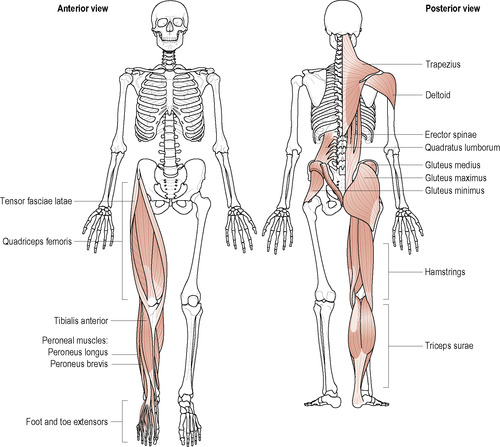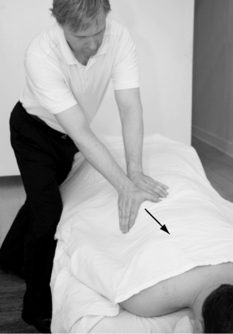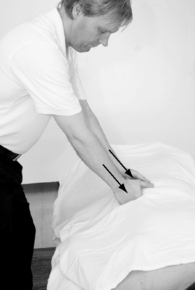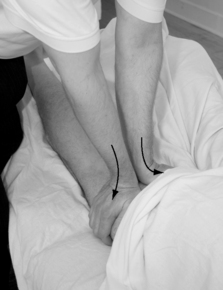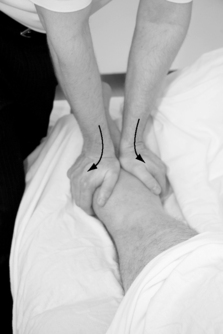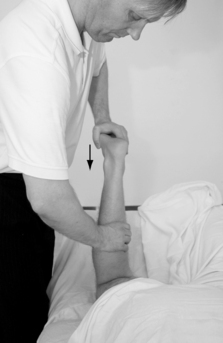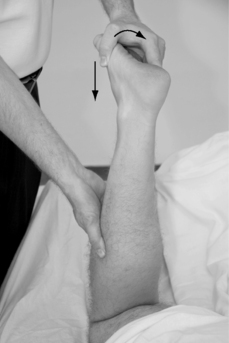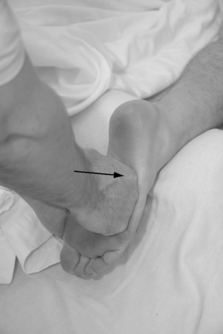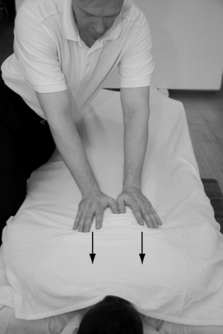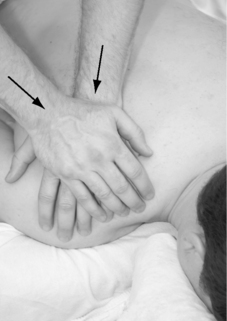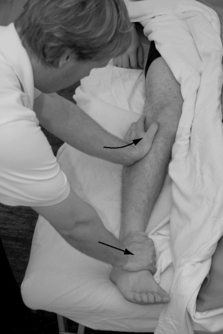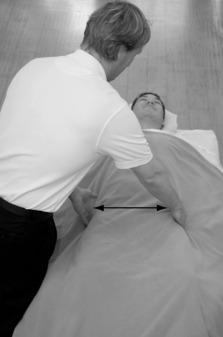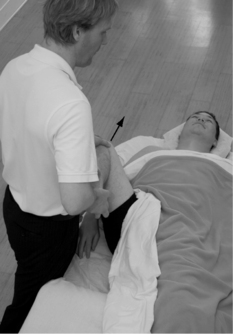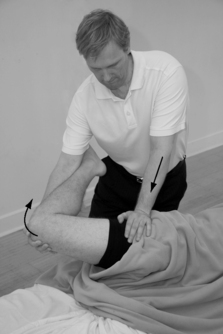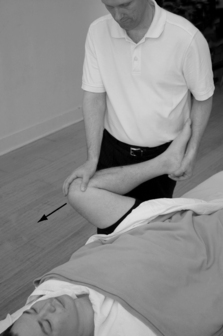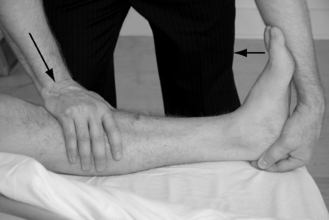4. Examples of event-based sports massage treatments
The following examples of applied pre-, inter-, and postevent massage treatments are basic suggestions, which can be helpful for the novice sports massage therapist. It is important to realize, however, that a large number of options exist in real treatment situations since a good sports massage therapist continuously needs to adapt to existing scenarios including the requirements of each athlete treated during competition or training events.
Preevent sports massage treatment
Since preevent sports massage is aimed at preparing the athlete for a more or less imminent upcoming event (Meagher and Broughton, 1990, Ylinen and Cash, 1993, Benjamin and Lamp, 1996, Cash, 1996, Hemmings, 2001 and Archer, 2007), the standard treatment duration close to a competition or training session is ideally around 15–20min. Preevent massage is thought to stimulate increased blood circulation through activation of autonomic vascular reflexes (Gillespie 2003). The speed of the massage strokes is, as previously mentioned, also faster compared with a regular massage treatment, preferably more rapid than the athlete’s resting heart rate, to ensure that the athlete stays alert and maintains their “mental peak” prior to the competition.
The following example will describe a preevent treatment of a long distance runner. In this case, the main areas treated areas are the feet, legs, hips/gluteal area, lower back, neck, and shoulders (Fig. 4.1). The massage always starts with a focus on the most frequently used areas for each athlete, which for most sports are the legs.
The time distribution for each sports massage treatment must be planned in advance to ensure treatment of all necessary areas of the athlete’s body. As the following example illustrates, it is easy to see the actual time limitations imposed for each area. Every applied massage stroke must therefore be highly effective with regards to execution of technique, timing, and focal intent. It may be easier for the less experienced sports massage therapist at first to choose from a limited group of strokes with more general effects, initially keeping the treatment very basic by perhaps employing only four to five different strokes, using them systematically and thoroughly to ensure a real effect in the treated tissues. Supplementary strokes are added later, when the therapist is more confident about the treatment and the strokes’ beneficial effects are relevant to the treatment goals.
Examples of some common massage strokes used during preevent massage
• effleurage
• scrubbing
• jostling/oscillation
• compression techniques – palm, fist, elbow
• broadening – palm heel, thenar eminence
• petrissage – palm
• frictions – transverse and circular
• edging
• rubbing – thenar, hypothenar
• rolling
• light tapotement.
Example of time distribution of a preevent sports massage treatment
| • Back of left leg including the foot | 3min |
| • Back of left gluteal area, hip, and lower back | 2min |
| • Back of right leg including the foot | 3min |
| • Back of right gluteal area, hip, and lower back | 2min |
| • Upper back and shoulder area | 2min |
| • Front of left leg | 2min |
| • Front of right leg | 2min |
| • Gentle stretches and ROM movements | 4min |
| Total: | 20min |
Suggestion for a general preevent sports massage treatment
1. Jostling of both legs. The therapist grabs both heels and rocks them side to side (Fig. 4.2). This movement will transfer to the rest of the body. The therapist looks for areas of restricted movements as the whole body moves from the jostling. It is easy for the therapist to notice areas in need of additional treatment.
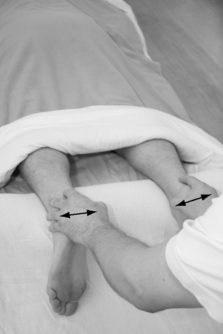 |
| Figure 4.2 |
2. Palm scrubbing of the posterior aspect of the right leg, gluteal area, and lower back (Fig. 4.3). Palm scrubbing generates heat and is ideal to use in preevent massage when environmental temperatures are lower, or if the athlete feels cold.
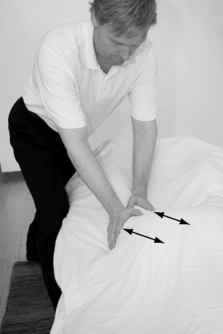 |
| Figure 4.3 |
3. Effleurage of the back of the right leg. The athlete is lying prone with a bolster under the feet. Use a sheet to cover the athlete’s body and/or an added blanket if the temperature is cooler. It is many times easier to work through a sheet since it creates a smooth and even surface to massage on. This stroke starts superficially with the whole surface of the palms and is gradually deepened, by increasing the angle of the hands, as the tissue warms up (Fig. 4.4).
 |
| Figure 4.4 |
4. Effleurage of the right gluteal and lower back area including gluteus maximus, medius, minimus, quadratus lumborum, and erector spinae muscles (Fig. 4.5).
5. Fist compressions of the right gluteal and lower back muscles. The stroke is initially light, and deepens slightly as the tissue warms up (Fig. 4.6).
6. Fist and palm compressions of the ischiocrural/hamstring muscle group. The muscles are massaged from origin to insertion and special attention is placed on abnormally tight areas (Fig. 4.7).
7. Broadening of the ischiocrural/hamstring muscle group. Palmar or thenar broadening is used depending on the size of the thigh (Fig. 4.8).
9. Rhythmic lock and stretch of the soleus and tibialis posterior muscles. The right knee is flexed and foot passively plantar flexed. The calf muscle is grasped on the lateral aspect as the therapist uses the elbow to perform dorsal flexion of the athlete’s ankle. The athlete remains relaxed as the muscles systematically are compressed and stretched along the length of the treated muscles (Fig. 4.10). This massage and stretch also includes the calcaneus tendon.
10. Rhythmic lock and stretch of the peroneal muscles. The right knee is flexed and foot passively plantar flexed and inverted. The peroneal muscles are locked with one thumb, as the foot is dorsal flexed. The inversion should be approximately 50% of maximal movement to avoid pinching in the ankle joint. The athlete remains relaxed as the muscles systematically are compressed and stretched along the length of the treated muscles (Fig. 4.11).
11. Edging of the right calf muscle. The side of one thumb or tip of both thumbs is edging each belly of the gastrocnemius muscle (Fig. 4.12).
 |
| Figure 4.12 |
13. Effleurage of the right leg and gluteal area (Fig. 4.14).
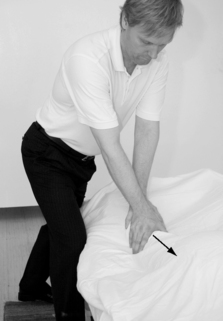 |
| Figure 4.14 |
Repeat sequence 2–13 on the left leg,
17. Effleurage of the right leg. The therapist gradually increases the depth slightly as the tissue warms up by increasing the angle of the hands (Fig. 4.18).
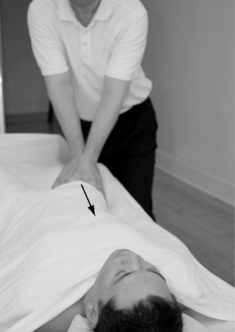 |
| Figure 4.18 |
18. Fist and palm compressions of the right thigh. The entire anterior and lateral aspects of the thigh are massaged (Fig. 4.19).
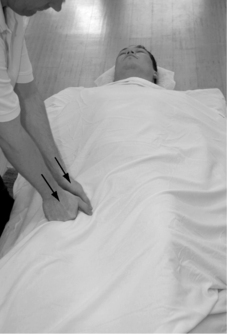 |
| Figure 4.19 |
19. Palm broadening of the right thigh. The tips of the fingers initially lift the medial and lateral aspects of the muscles, followed by a laterally sliding compression by the heels of the hands (Fig. 4.20).
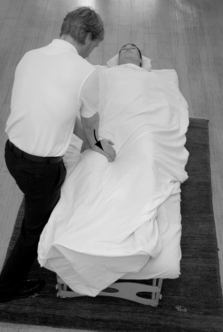 |
| Figure 4.20 |
20. Hypothenar rubbing of right quadriceps muscle. The rubbing stroke starts slowly, and the speed is gradually increased as the tissue warms up (Fig. 4.21).
 |
| Figure 4.21 |
21. Palm compressions of the right tibialis anterior and peroneal muscles. The compressions span the whole length of the anterior and lateral compartments, while a slight lateral (for tibialis anterior) and posterior (for the peroneal muscle group) direction is added to the compressions to enhance the stretch effect (Fig. 4.22).
Repeat sequence 16–21 on the left leg.
30. Stretch of left quadriceps and iliopsoas muscles with additional hip lock by the therapist, athlete positioned on side (Fig. 4.31).
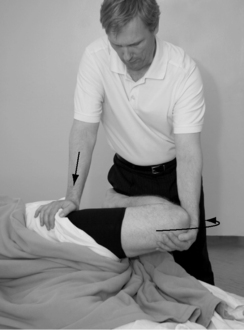 |
| Figure 4.31 |
Only gold members can continue reading. Log In or Register to continue
Stay updated, free articles. Join our Telegram channel

Full access? Get Clinical Tree



